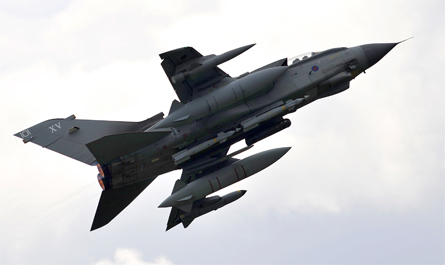One of the UK Royal Air Force's combat crews visited the show on Tuesday to detail the Panavia Tornado GR4's lead role in the offensive element of NATO's mission to protect Libyan civilians.
Tornado pilot Flt Lt Mark Lawson and weapon systems operator Flt Lt James Cooke, from the RAF's 9 Sqn, were involved from the launch of the ongoing operation. An early strike mounted from the unit's base at Marham, Norfolk, in March saw four aircraft release eight MBDA Storm Shadow cruise missiles in a long-distance mission which lasted 7.5h. "Direct hits were seen on the targets," said Cooke.
 |
|---|
© Crown Copyright |
The GR4s were subsequently relocated to Gioia del Colle air base in Italy, while their activities were widened to also include the use of the Goodrich Raptor reconnaissance pod and a range of ground-attack weapons.
The latter have included the Raytheon Systems Paveway IV precision-guided bomb and MBDA's laser-guided dual-mode Brimstone air-to-surface missile. Described by Lawson as "the weapon of choice for urban targets", Brimstone has attracted recent interest from the French and US militaries. Key attributes include the design's precision, reduced-collateral effect and speed of targeting, he said.
GR4s have also carried MBDA ASRAAM air-to-air missiles for the first time operationally over Libya.
"The GR4 is still the only [UK] platform with deep-strike, suppression of enemy air defence and really good reconnaissance capabilities," said Lawson. However, operating the type in a two-ship formation with a Eurofighter Typhoon has allowed the Tornado crew to access improved situational awareness which he said has been "a real eye-opener for us".
If needed, 9 Sqn's personnel will return to Italy again later this year to participate in the Libyan campaign. "We'll be there waiting if a target comes up," said Lawson.
- All the latest news, images and video from the 2011 Paris air show
Source: Flight Daily News



















